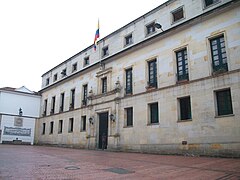Palacio de San Carlos (Bogotá)
| San Carlos Palace | |
|---|---|
| Palacio de San Carlos | |
 |
|
| Former names | Colegio Seminario de San Bartolomé |
| General information | |
| Architectural style | Neoclassical |
| Address | Calle 10 № 5-51 |
| Town or city | Bogotá, D.C. |
| Country | Colombia |
| Coordinates | 04°35′49.99″N 074°04′32.03″W / 4.5972194°N 74.0755639°W |
| Current tenants | Ministry of Foreign Affairs |
| Completed | c. 1580 |
| Owner | Government of Colombia |
| Technical details | |
| Floor count | 3 |
The San Carlos Palace (Spanish: Palacio de San Carlos; previously Colegio Seminario de San Bartolomé), is a 16th-century Neoclassical mansion in Bogotá, Colombia. Located on the corner of Calle 10 and Carrera 5, the historic building has been the site of various political, social and academic events. Since December 1993, it has been home to the Ministry of Foreign Affairs.
The Palace of San Carlos The history of the building goes back to the end of the 16th century when it was built by Archdeacon Francisco Porras Mejia, in 1585. At the time Santa Fe de Bogotá was the capital of New Kingdom of Granada, part of the Viceroyalty of Peru. It was occupied by the archdeacon's family until 1605 when it was sold to Archbishop Bartolomé Lobo Guerrero who used it as a Jesuit seminary known as the Colegio Seminario de San Bartolomé. In 1739, the first printing press of Sante Fe was also established here. In 1767, after the Jesuits were expelled from New Granada by Francisco Antonio Moreno y Escandón, acting on orders from King Carlos III, it became the Royal Library of Santa Fe and served as barracks for the Presidential Guard. From 1827 to 1908 the palace was the official residence of the President of Colombia. Then President Rafael Reyes Prieto moved out to the Palace of Nariño where he lived till 1954. From 1954 it again became the residence of General Gustavo Rojas Pinilla and his successors till 1980. In 1980 after the Palace of Nariño was inaugurated as the presidential residence, the Palace of San Carlos was converted to house the Ministry of Foreign Affairs which it still accommodates today.
The palace was also the scene of an assassination attempt on Simon Bolivar in 1828. He was attacked when a group of conspirators attempted to assassinate him while he was taking a bath and he escaped through the window with soap still covering his body. His mistress, Manuela Sáenz Aizpuru, who tipped him off and saved him came to be known among Bogotans as "the liberator of the liberator". The event became known as the Noche Septembrina (English: September's Night, and it is referenced in Latin in a plaque conspicuously fixed on the wall next to the window through which he escaped. In 1937, properties next to the palace were acquired on the eastern side. The main entrance was added along with a triple storied building to accommodate the offices of the Ministry. Built by the Italian architect Pietro Cantini, the new façade stands close to two other historic buildings on Calle del Coliseo (Calle 10): the birthplace of the poet Rafael Pombo and the Christopher Columbus Theatre. On 11 August 1975, the San Carlos Palace was declared a National Monument.
...
Wikipedia
